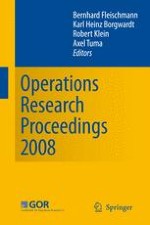2009 | OriginalPaper | Buchkapitel
Detecting Orbitopal Symmetries
verfasst von : Timo Berthold, Marc E. Pfetsch
Erschienen in: Operations Research Proceedings 2008
Verlag: Springer Berlin Heidelberg
Aktivieren Sie unsere intelligente Suche, um passende Fachinhalte oder Patente zu finden.
Wählen Sie Textabschnitte aus um mit Künstlicher Intelligenz passenden Patente zu finden. powered by
Markieren Sie Textabschnitte, um KI-gestützt weitere passende Inhalte zu finden. powered by
Symmetries are usually not desirable in integer programming (IP) models, because they derogate the performance of state-of-the-art IP-solvers like SCIP [1]. The reason for this is twofold: Solutions that are equivalent to ones already discovered are found again and again, which makes the search space \unnecessarily large". Furthermore, the bounds obtained from the linear programming (LP) relaxations are very poor, and the LP-solution is almost meaningless for the decision steps of the IP-solving algorithm. Overall, IP-models mostly suffer much more from inherent symmetries than they benefit from the additional structure. Margot [4, 5] and Ostrowski et al. [7, 8] handle symmetries in general IPs, without knowing the model giving rise to the instance. Kaibel et al. [2, 3] took a polyhedral approach to deal with special IP-symmetries. They introduced orbitopes [3], which are the convex hull of 0=1-matrices of size p X q, lexicographically sorted with respect to the columns. For the cases with at most or exactly one 1-entry per row, they give a complete and irredundant linear description of the corresponding orbitopes. These orbitopes can be used to handle symmetries in IP-formulations in which assignment structures appear, such as graph coloring problems; see the next section for an example. All of the above approaches assume that the symmetry has been detected in advance or is known. Therefore, automatic detection of symmetries in a given IP-formulation is an important task. In this paper, we deal with the detection of orbitopal symmetries that arise in the orbitopal approach. While this problem is polynomially equivalent to the graph automorphism problem, whose complexity is an open problem, orbitopal symmetries can be found in linear time, if at least the assignment structure is given. Otherwise we show that the problem is as hard as the graph automorphism problem.
